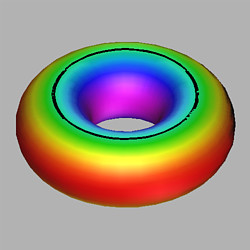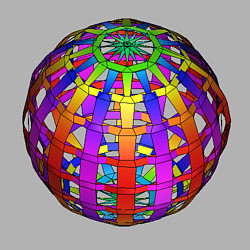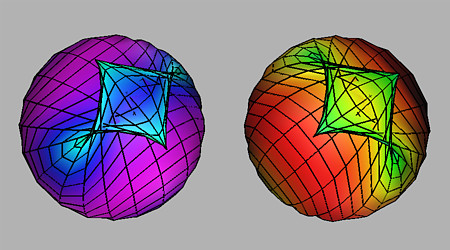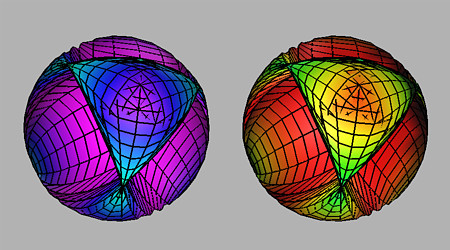



 0 then X is regular, and for
x > 0 the unif normal is
0 then X is regular, and for
x > 0 the unif normal is


The parabolic set occurs when
0 =  = -f'(x) f"(x),
i.e. at extrema or at inflections of the profile curve. Furthermore,
grad
= -f'(x) f"(x),
i.e. at extrema or at inflections of the profile curve. Furthermore,
grad  = (-(f"(x))2 - f'(x) f'''(x), 0),
so Ñ is good if f"(x) = 0 implies
f'(x)
= (-(f"(x))2 - f'(x) f'''(x), 0),
so Ñ is good if f"(x) = 0 implies
f'(x)  0 and
f'''(x)
0 and
f'''(x)  0.
0.
If x0 is a value for which f''(x0) = 0, then the parabolic curve can be parametrized by x(t) = x0, y(t) = t, and we obtain

 0 and
f'''(x0)
0 and
f'''(x0)  0, then the Gauss map
has an ordinary fold along the parabolic curve. For example, these
conditions are satisfied by the bell surface:
0, then the Gauss map
has an ordinary fold along the parabolic curve. For example, these
conditions are satisfied by the bell surface:

On the other hand, if x0 is a value for which
f'(x0) = 0 and
f"(x0)  0, then the Gauss map
is good, but not excellent, because the parabolic curve is
parametrized by x(t) = x0,
y(t) = t, and
N(t) = (0, 0) for all t. An example is the top
of a torus of revolution:
0, then the Gauss map
is good, but not excellent, because the parabolic curve is
parametrized by x(t) = x0,
y(t) = t, and
N(t) = (0, 0) for all t. An example is the top
of a torus of revolution:




Let  be a regular space curve wit curvature nowhere zero.
Define the canal surface about
be a regular space curve wit curvature nowhere zero.
Define the canal surface about  of radius r to be
of radius r to be

where P and B are the principal normal and the binormal of the
curve  . To find the normal of the surface X, we form
. To find the normal of the surface X, we form


where  and
and  are the curvatuer and torsion of
are the curvatuer and torsion of  ,
and s is the arclength along
,
and s is the arclength along  . Then
. Then


so the parabolic set occurs when the two vectors


are linearly dependent, i.e. when
 cos y = 0. This occurs at the curves
x(t) = t,
y(t) = ±
cos y = 0. This occurs at the curves
x(t) = t,
y(t) = ± /2, for which we have
/2, for which we have

A straightforward calculation gives the Gaussian curvature
K =  cos y/(r (r
cos y/(r (r cos y - 1))
and
cos y - 1))
and
 K/
K/ y =
y =  sin y/(r (r
sin y/(r (r cos y - 1)2),
so K = 0 implies grad K
cos y - 1)2),
so K = 0 implies grad K  0,
since
0,
since 
 0. Therfore the Gauss map is good. Now
taking derivatives with respect to t, we obtain
0. Therfore the Gauss map is good. Now
taking derivatives with respect to t, we obtain


so N' = 0 if and only if  = 0 and
then N" =
= 0 and
then N" =  's'P. So the Gauss
map N is excellent if
's'P. So the Gauss
map N is excellent if  '
'  0 whenever
0 whenever
 = 0, and then N(x, y) has a
cusp at (t ,±
= 0, and then N(x, y) has a
cusp at (t ,± /2) if and only if
/2) if and only if
 (t) = 0.
(t) = 0.
For example consider the warped torus, a canal surface of the space curve
 (t) = (cos t, sin t,
(t) = (cos t, sin t,  sin(nt))
sin(nt))
where n is an integer, n  2. The
curvature of
2. The
curvature of  is nowhere zero, since
is nowhere zero, since
 (s')3 = |(
(s')3 = |( ' x
' x  ")|
")|  1.
Furthermore
1.
Furthermore

so  = 0 if and only if
t =
= 0 if and only if
t =  /2n, 3
/2n, 3 /2n, ...,
(4n - 1)
/2n, ...,
(4n - 1) /2n, provided that
/2n, provided that

 0. Taking derivatives of
0. Taking derivatives of
 2
2 (s')^6 and
(s')^6 and
 n(1 - n2)cos nt
shows that tau = 0 implies
n(1 - n2)cos nt
shows that tau = 0 implies  '
'  0, so
long as
0, so
long as 
 0. Therfore a canal surface of
0. Therfore a canal surface of  has
an excellent Gauss map, with 4n cusps. For
has
an excellent Gauss map, with 4n cusps. For  = 0 a
canal surface of
= 0 a
canal surface of  is a torus of revolution, and each component
of the parabolic curve is collapsed to a point by the Gauss map.
is a torus of revolution, and each component
of the parabolic curve is collapsed to a point by the Gauss map.

